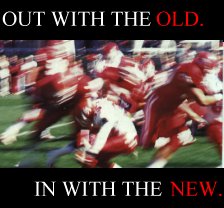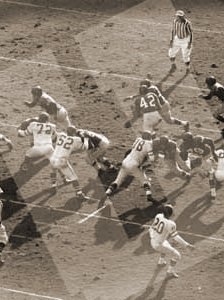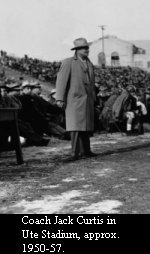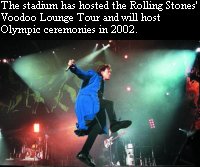
 |
Professor
Parry Sorensen's nostalgic look at where the Ute's have played, from
Cummings Field to magnificent new Rice-Eccles Stadium.
|
 There
aren't many of us still around who saw a football game on Cummings Field.
I saw my first game there in 1924 when I was eight years old. It was against
BYU, and, according to the record book, the Utes won 35-6. Though I had
to look up the exact score, I remember a halftime show that had a black-suited
and bearded man with a top hat leading a procession of women and children
across the field. Guess who he was supposed to be?
There
aren't many of us still around who saw a football game on Cummings Field.
I saw my first game there in 1924 when I was eight years old. It was against
BYU, and, according to the record book, the Utes won 35-6. Though I had
to look up the exact score, I remember a halftime show that had a black-suited
and bearded man with a top hat leading a procession of women and children
across the field. Guess who he was supposed to be?
Dave Freed BA'31, Utah's Mr. Tennis, has memories of Cummings Field that go back farther than mine. Not only does Dave remember going to games there, but he recalls the time when a strong windstorm blew the roof off the west stands.
Cummings Field was the home of Utah football from the turn of the century, when the campus moved from downtown, until the Ute stadium was built in 1927. At first it was a dirt field cleared of sagebrush, and when the rains came, it was a pile of mud. Then a good layer of sand was added a couple of years later. In 1910, the field was sodded and a sprinkling system installed. Before moving to the campus, most of the football games were played on Walker field at Ninth South and Main.
Eventually a high board fence was built, along with some wooden stands measuring 20 feet by 80 feet with a seating capacity of 500. More seats were added from time to time until the red-painted stands had a seating capacity of about 10,000.
 Cummings Field had no dressing rooms. Players of both teams had
to dress and shower in the gymnasium and walk a hundred yards to the field.
At halftime the teams had the choice of trudging back to the gym or gathering
in the center of the field for a few minutes of rest and talk from the
coaches.
Cummings Field had no dressing rooms. Players of both teams had
to dress and shower in the gymnasium and walk a hundred yards to the field.
At halftime the teams had the choice of trudging back to the gym or gathering
in the center of the field for a few minutes of rest and talk from the
coaches.
Cummings Field was named in honor of Byron Cummings, who came to the University in 1893 as an instructor in Latin and Greek when he was 33 years old. He became dean of the School of Arts and Sciences and filled in for one year as dean of the Medical School. He left the University in 1915, and later became president of the University of Arizona.
According to Walter Kerr, professor of languages, who wrote a history of Utah intercollegiate athletics, Dean Cummings was the leader in organizing the University Athletic Association in 1894 and was its first treasurer. Minutes of one meeting showed he was reimbursed $50 for expenses he had paid from his own pocket.
"Dean Byron Cummings was the father of athletics at the University of Utah," Kerr wrote in his history. Before the sagebrush-cleared field was fenced, Cummings would walk among the sideline spectators and ask for donations to the Athletic Association.
As interest in athletics grew along with the size of the University, the seating capacity was increased. The last game on Cummings Field was on Thanksgiving day in 1926 when the Utes and Aggies, both undefeated in conference play, met with the championship at stake. The year before, the Aggies had knocked Utah out of the championship in a 10-6 upset. This time, Utah won easily, 34-0. It was the beginning of a football dynasty that lasted for the 25 years that Ike Armstrong coached the Utes. Between 1925 and 1949, Utah won or tied for the conference title 13 times. From 1929 to 1932 , the Utes didn't lose a conference game.
 That
record Thanksgiving day crowd, plus the promise of more championship teams
under Armstrong, gave impetus to construction of a new, larger stadium.
By the next season a 20,000-seat stadium was a reality. Construction began
in March 1927, and the first game on the new field was played seven months
later on October 1. Utah beat Colorado Mines that day, 40-6.
That
record Thanksgiving day crowd, plus the promise of more championship teams
under Armstrong, gave impetus to construction of a new, larger stadium.
By the next season a 20,000-seat stadium was a reality. Construction began
in March 1927, and the first game on the new field was played seven months
later on October 1. Utah beat Colorado Mines that day, 40-6.
To build the new stadium, the University tried to get the 1927 legislature to approve a loan from the State. The House approved the loan unanimously, but the Senate dawdled and didn't get around to acting on it.
So a stadium trust was formed with President George Thomas as chair, and faculty and civic leaders as members. In the latter group were John Fitzpatrick, publisher of The Salt Lake Tribune, and former Governor Charles Mabey. Tax-free bonds were issued, and some money was raised by selling tickets that gave the buyers two seats to every home game for the next 10 years. The cost for the 10-year tickets was $50, about a dollar a game. That $50 will get you a pair of tickets to a single game today.
The total cost of the new stadium was $133,000 – less than the cost of an average house today. The tax-free bonds were paid off in 12 years.
The new stadium was formally dedicated at halftime of the Utah-Colorado game on October 22, 1927. Professor Kerr's history records that there were 18 officials and guests on the field for the dedication. A special guest was Crown Prince William of Sweden, who was on a nationwide goodwill tour. He became King Gustav V in 1950. The prince got the loudest applause of the day when he gave the shortest speech of the day. "Hello, everybody," he said. "I wish everybody good luck."
Until 1947 the north end of the horseshoe was just a pile of dirt. That year the state helped finance an addition of 10,000 seats at the north end to provide an outdoor amphitheater for the presentation of Promised Valley, a feature of the state's centennial celebration.
For the next 20 years, that amphitheater saw extensive use for summer music festivals and commencements. The festivals featured grand operas and musicals with Broadway and Hollywood stars, along with the Utah Symphony. Beverly Sills sang the lead in Naughty Marrieta and La Traviata when she was a budding star in her twenties. Patricia Morrison was featured in Kiss Me, Kate just a few months after singing the lead role on Broadway for three years. Kitty Carlisle had the leading role in Carmen, and Dennis Day was a cowboy in Destry Rides Again.
 Before
the north end was finished, a few summer shows were presented in front
of the stadium's west stands. In the '30s a touring company from Europe
staged a version of the Passion play. One of the most popular musical
artists to appear was Larry Adler, the harmonica virtuoso. For many years
the Mutual Improvement Association dance festival of the Church of Jesus
Christ of Latter-day Saints was a regular feature every June.
Before
the north end was finished, a few summer shows were presented in front
of the stadium's west stands. In the '30s a touring company from Europe
staged a version of the Passion play. One of the most popular musical
artists to appear was Larry Adler, the harmonica virtuoso. For many years
the Mutual Improvement Association dance festival of the Church of Jesus
Christ of Latter-day Saints was a regular feature every June.
A million dollar gift from Bob Rice helped pay for an extensive face-lift in the early '70s. More seats were added at the south end, along with new dressing rooms. The playing field was lowered and the running track eliminated. Several thousand chair seats replaced many of the old wooden bleachers, and the scholarship box was built atop the east stands. The rickety old wooden press box was torn down and replaced with state-of-the-art accommodations for the media.
The last musical event in the stadium was the appearance of the Irish rock group U2 in 1997 before a sellout crowd at $42-$57.50 a ticket. In October 1994, the Rolling Stones played for a packed house, and even neighbors in nearby Federal Heights were treated to a performance by legendary rocker Mick Jagger, whom they could hear quite clearly from the comfort of their own patio furniture.
But Stones fans weren't the only ones to discover in the stadium a source of satisfaction. Magnificent improvements were unveiled at a Labor Day open house attended by an estimated 20,000 to 25,000 eager fans. After undergoing renovation that increased capacity to 45,600 seats and added a four-level press box with suites and club seating, the Utes have a fitting new home. It was christened Rice-Eccles Stadium in appreciation of a ten-million-dollar-gift from the Eccles Foundation.
Gone are both the humble ambience of football played on dirt fields cleared of sagebrush, and the creaking, crumbling features of the antiquated Rice Stadium. In just three years their Olympian replacement will host opening and closing ceremonies for the 2002 Winter Games. The gleaming structure is simply splendid.
– Ute fan Parry Sorensen BA'36 is professor emeritus in the Department of Communication. After teaching 46 years at the U, he takes in football games from near the 50-yard line.
Copyright 1999 by The University of Utah Alumni Association